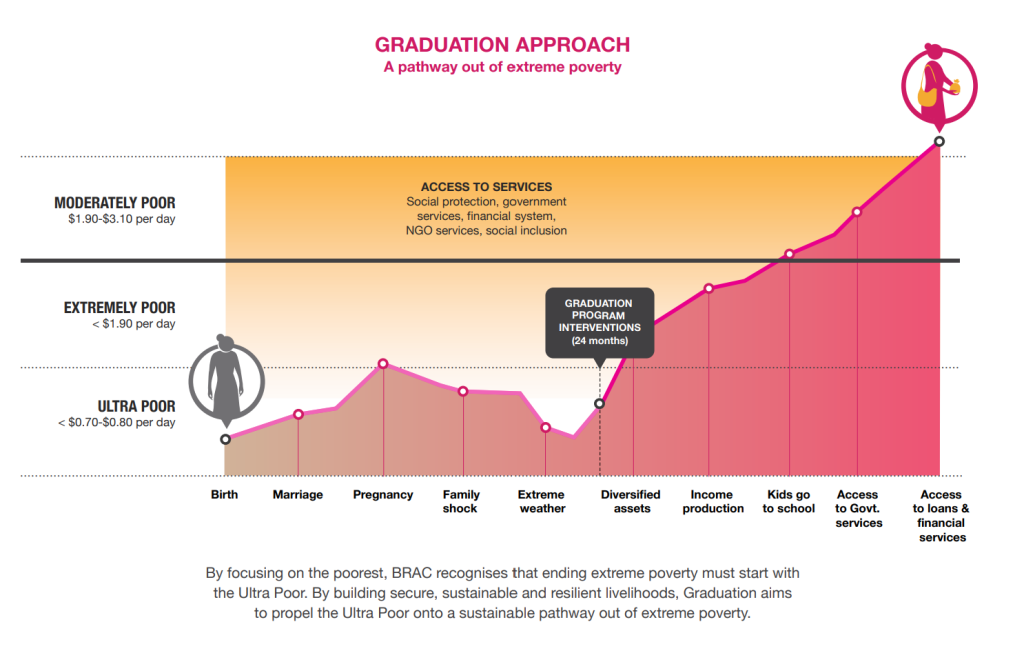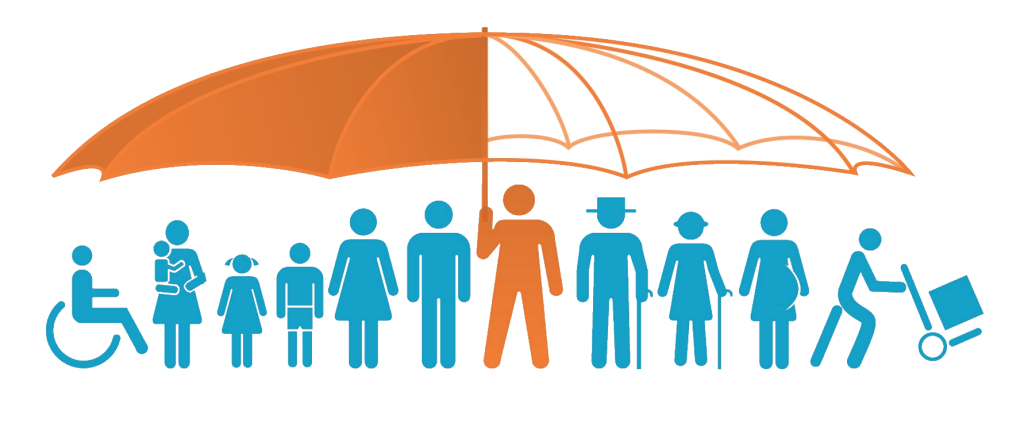Social Protection Systems in Developing Economies; Targeting the Ultra Poor through a “Graduation Approach”

In developing economies, Governments are increasingly developing and implementing ‘Graduation’ type interventions as part of their Social Protection Strategies. When considering this trend, and how the vulnerabilities related to extreme poverty, gender, disabilities, etc are addressed through the “Graduation Approach” the following questions comes to mind:
Can individuals permanently graduate out of ultra poverty?
What criteria determine an individual’s eligibility to graduate from poverty within a social protection framework?
How long does it typically take to progress from one poverty level to self-sufficiency?
Reflecting on these questions, this article explores the key concepts and ideas related to the Graduation Model, while focusing on the intersection of social class categorization, targeting strategies, and intersectionality. It examines how these factors relate to different levels of poverty as defined within the BRAC Graduation Model.
‘Ultra Poor’ are those in extreme poverty (poorest of the poor), having multidimensional challenges including food insecurity, poor health, limited skills, limited assets and savings, basic social safety nets, lack of support from government and NGO services.
In the realm of global development, one of the critical challenges facing policymakers and practitioners is the enhancement of social protection systems in developing economies.
Social protection encompasses a range of interventions designed to support individuals and families against economic and social risks. These risks can include poverty, unemployment, illness, disability, and old age. Effective social protection systems not only mitigate these risks but also contribute to broader objectives of inclusive growth, poverty reduction, and sustainable development.
Developing economies often face unique obstacles in establishing robust social protection systems due to limited fiscal resources, institutional capacity constraints, and diverse socio-economic contexts. These challenges impact the National Government’s ability to run successful and sustainable Social Protection packages independently for its citizens. To cushion the impact of these gaps, Non-Profit Organizations (INGOs, IGOs and NNGOs) and their foreign donors contribute immensely to the alleviation of extreme poverty amongst the poor and most vulnerable through livelihood interventions in line with the so-called “Graduation Model” but often connected with the sustainable development goals (SDGs)
Graduation from Social Protection; BRAC’s Graduation Model
One Social Protection Approach which has gained a lot of attention in the past is the “Graduation Model”, developed by BRAC in the early 2000’s, which specifically targets and uplifts the “ultra poor” segments of society. The BRAC Graduation Model was developed and piloted in Bangladesh, and have been duplicated in India, Uganda, South Sudan, and Afghanistan.

The Graduation Model comprises 5 stages. Initially, the program selects the poorest households based on specific criteria, which includes the absence of productive asset ownership and no active male members in the household. In the second stage, selected households begin receiving consumption support to stabilize their access to essential daily needs.
Moving into the third stage, households are encouraged to initiate saving behaviors by opening individual accounts with a microfinance organization. This stage not only aims to facilitate asset building but also to foster financial discipline among program participants and acquaint them with the microfinance institution. The fourth and fifth stages are arguably the most important parts of the program. During the fourth stage, participants undergo skills training to learn how to manage an asset and run a business effectively. Finally, in the fifth stage, participants receive a subsidized asset transfer to help them start an economic activity, thereby supporting their path towards sustainable livelihoods. Moreover, peer support through group meetings and self-help groups plays a crucial role in building the confidence of program participants. Overall, the program typically spans between 2 to 3 years, encompassing all five stages mentioned earlier. This duration allows sufficient time for participants to progress through each stage, acquire necessary skills, establish financial habits, and ultimately transition towards sustainable economic activities.
The combination of targeted support, skill-building, financial inclusion, and peer empowerment contributes to the program’s effectiveness in lifting households out of poverty and promoting long-term economic resilience.
Adaptation of the “Graduation Model” in National Social Protection Policy
Governments are increasingly adapting and implementing ‘Graduation’ type interventions as part of their Social Protection Strategies. One case in point is an example from my home country Nigeria:
Nigeria developed its first comprehensive National Social Protection Policy in 2016, providing a framework on how the country intend to address poverty and social inequalities through dignified support services for all marginalized and most vulnerable citizens. The policy presents the National Social Protection support services under 8 categories as follows: (1) Education and Health support services, (2) Social welfare and child protection, (3) social housing, (4) livelihood and employment, (5) social insurance scheme, (6) Social assistance, (7) Traditional family and community support, (8) Legislation and regulation. Within the policy, the approach that would be taken to coordinate the identification of beneficiaries and the implementation of support services is provided. According to the policy, beneficiaries would be targeted for support in a timely and systematic way; after the intervention, beneficiaries would be ‘graduated and exited’ from the program and then linked with other complementary services. However, Persons with disabilities and the elderly, who are recognized as part of the most vulnerable, would be sustained in the system for continuous support. In implementing this policy, the Government has implemented several programs in the past including; Conditional Cash Transfer projects, Micro Credit Scheme, Operation Feed the Nation etc, which had huge impact in the lives of the beneficiaries, but the sustainability of this impact is still questionable because of various socio economic and political factors.
As the graduation model adopts a theory of change as a determiner to measure the transformative impact of short-to-midterm livelihood interventions targeted at persons living below a pre-defined poverty line, the question: whether the participants of these graduation programs, graduate from the defined lines of extreme poverty for a lifetime, remains an open and controversial discussion in Nigeria.
Conclusion
In assessing the Graduation Model of social protection, it is important to recognize both its potential strengths and weaknesses, particularly in terms of economic profitability and social impact. While the direct economic profitability of the model may not have been definitively proven, there are anticipated longer-term benefits for institutions partnering on the program like – microfinance organizations as ultra-poor individuals graduate from the program and potentially become their customers. However, the model’s ultimate success should not solely be measured in terms of immediate economic returns but rather in its broader social impact and contribution to sustainable development.
From a social impact perspective, the Graduation Approach has however demonstrated significant benefits for ultra-poor individuals in the countries where it has been implemented.
By targeting the poorest of the poor in developing economies, the model has effectively reduced the margin of extreme poverty, empowering individuals and households to build sustainable livelihoods. This positive social impact is a testament to the potential of holistic interventions that address multiple dimensions of poverty. Nevertheless, the sustainability of this impact remains a challenge due to various factors.
Economic instability, such as inflation or financial crises, can undermine the gains achieved through the Graduation Model. Social and cultural factors within communities may also influence the long-term outcomes of the program, affecting beneficiaries’ ability to maintain their progress after the intervention ends.
To address these challenges and maximize the model’s effectiveness, continued investment in monitoring, evaluation, and adaptation is essential. Programs should be designed with a focus on sustainability, ensuring that participants have the necessary support and resources to navigate economic fluctuations and social dynamics beyond the intervention period.
While the Graduation Model of social protection shows promise in lifting individuals from an ultra-poor state to a moderately poor state and fostering social inclusion, its long-term success on completely eradicating poverty is not yet holistically proven. By recognizing and mitigating potential pitfalls, stakeholders can work towards ensuring that the model contributes meaningfully to sustainable development goals and lasting positive change in the lives of vulnerable populations.
What other thoughts, examples or case studies would you like to share on the impact of Graduation Models from your own perspective, or with reference to your country’s Social Protection Strategy? Feel free to add in the comment section below.

